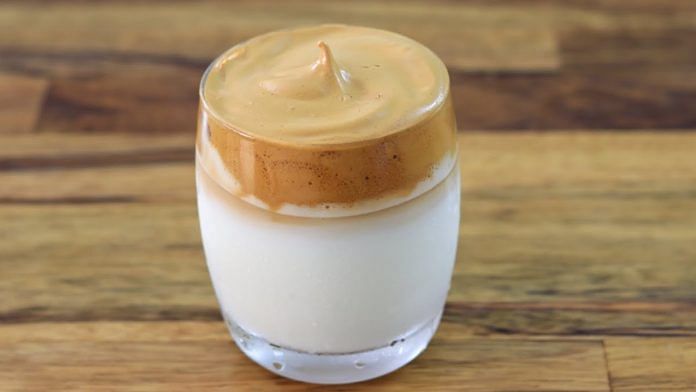Dalgona coffee has been expelled from our vocabulary and menu. And, we’re all better off without it.
For all the effort (and sore wrists), the result was a sugary, frothy drink that barely tasted like coffee.
People want to drink coffee, not eat some sugar-loaded foam.
Sure, it looked cool, but in retrospect, it was all about style over substance.
Dalgona coffee emerged as one of the biggest food trends of the Covid-19 pandemic, thanks to a bunch of South Korean YouTubers.
The coffee is made by vigorously mixing instant coffee and sugar. South Korean actor Jung Il-woo is credited with making Dalgona coffee a viral trend. He popularised the drink on a TV show called Stars’ Top Recipe at Fun-Staurant where he ordered and compared it to the Korean honeycomb toffee called ‘dalgona’. It was soon picked up by TikTok and Instagram enthusiasts.
The excitement surrounding this trend was evident, with Instagram reels demonstrating the step-by-step process of making the beverage racking up views in millions. Indians gave the whipping process their own touch. Instead of beating with a spoon or using an electric beater, making the beverage with a tea strainer went viral. Then there were mixologists, who converted it into an espresso martini.
The hashtag #dalgonacoffeechallenge has garnered over 86,000 mentions, while more than 6,00,000 posts feature the hashtag #dalgonacoffee, showcasing its widespread popularity.
Everyone I know of has tried making it at least once. And, outrightly rejected it.
“It doesn’t taste like coffee”, “too sweet”, “too much effort”, they said.
For one, dalgona barely tasted like coffee. Let’s be real: True coffee lovers want a bold, rich flavour that screams ‘morning pick-me-up’, not a spoonful of foam.
This was more about the Instagram picture than the actual experience of drinking coffee. All those sugary swirls and milk were a cute gimmick.
But, for many, dalgona coffee wasn’t a new concept.
Also read: India gets unfairly bashed for unhygienic street food. Bangkok, New York are no different
Not a serious brew
Beaten coffee — the one you whip with a spoon in a glass or bowl — is popular in Indian kitchens. Dalgona was just a fancier name.
The trend picked up because the ingredients were available in everybody’s pantry, the process wasn’t rocket science, and people had too much free time.
As life got back on track, the idea of dalgona coffee became much of a headache. Even cafes, which introduced this beverage in their menus, parted ways.
Then there’s the effort factor. The viral videos made it look so easy—until you were five minutes into whisking and your arm was sore.
And for what? A drink that deflated in minutes, tasted like melted sugar, and looked nice for exactly two seconds.
Today, I see dalgona as a dessert rather than a serious brew, appealing mostly to those with a sweet tooth and a love for theatrics.
Its flavour is a far cry from a genuine coffee experience; instead, it tasted like a candy-coated version that masked the actual coffee.
Farewell, dalgona
The trend’s quick disappearance is actually a relief.
I suspect there’s a tiny group out there, probably the same folks who once loved dunking bread in hot, sugary milk, still secretly obsessed with dalgona. But you won’t see them flaunting it online—they’re way too embarrassed for that.
Instead, they make it quietly when no one’s around, like a guilty pleasure they’d rather keep hidden from the world, for fear of being judged.
Meanwhile, the world returned to actual coffees—rich espressos, balanced pour-overs, and black brews that don’t need a whisk and half a cup of sugar.
These drinks have depth, complexity, and character that dalgona just couldn’t touch.
There’s something refreshing about letting go of fads that are all flair and no substance. So, good riddance to dalgona coffee; may we never have to endure another cup of it.
Views are personal.
(Edited by Humra Laeeq)






